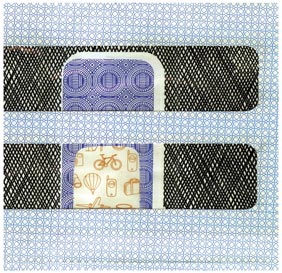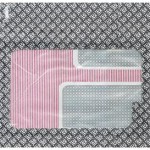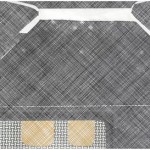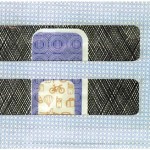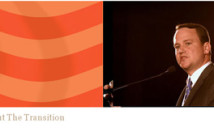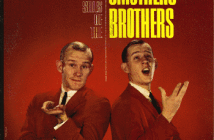I had the wonderful opportunity this past weekend to see an excellent exhibition in Boston that demonstrates, in the best way, how a set of ideas can be given interesting and engaging form. Correspondence, an installation by the Waltham/Andover based artist Ceci Mendez uses a most minimal set of means to create a most engaging set of objects. Taken at face value, the idea is simple enough: to use recycled business envelopes, and to then cut and collage them individually and present them as a group in a room sized installation. This might describe in a material sense what the artist has done, but it doesn't begin to describe the complexity, intelligence, and deeply layered meaning embedded in the work.
The envelopes are of the type that come with patterns printed on the inside, the better to obscure the private information being mailed within them. In case you haven't looked in there lately before discarding them, from the evidence of Mendez's collages, the inside of these envelopes contain an arrestingly myriad number of patterns, intricately designed in some cases, and all designed to keep out prying eyes. The irony of this is, of course, that anyone with a modicum of technical savvy and a few dollars (or the will to simply tear on of these envelopes open) can probably get at the information that is being so shoddily and ornately protected. In this way the artist begins to draw us into the more complex social dimension of these visually engaging objects.
While they are ostensibly about using and reusing certain visual forms contained within this printed matter, the ever intruding presence of the constantly evolving information age looms heavily over this project as a meaningful subtext. The recognition of this is not at all intended to diminish the formal wit and savvy of the work. For unlike a lot of work that has been create in the postmodern moment--in which the idea(s) behind the art object seem to have more currency than the objects themselves--Mendez clearly delights in the pleasure of working with her material to craft a visually sustained experience that engages both the mind and the more emotive parts of our being. She has been collecting these envelopes for a number of years, storing up both material and ideas.
This is an artist who clearly relishes the chance to dig into these encoded patterns and make them her own. First cutting the envelope into a uniform square shape, she then uses bits and pieces of other envelope patterns and joins them with the larger dominant pattern, making free and recurring associations between the various patterns and colors. The envelope windows are a key formal device here as well. These shifting forms are then thoughtfully amplified through the final arrangement of the individual pieces into a large fractured grid that wraps around the three walls of the small gallery space. One gets the feeling that Mendez would have kept going had she had more walls to cover; the dizzying effect of these recurring and shifting colors and forms within the uniform square paper shapes is at once overwhelming in their entirety, and intimately revealing as one peruses them individually.
There is humor here too, as when an individual square wraps around the door frame at the end of a wall, or when yet another hovers just slightly above the floor, appearing to demand its own space away from the group. And others occasionally hover above the gridded others, drawing our attention upward, punctuating the experience with a wonderful note of both idiosyncratic humor, and formal irregularity. In this use of irregular patterning Mendez's collages recall, too, a central formal trope of much of San and Mbuti African textiles, which also make use of an irregular patterning device.
These works make a clear nod also to key American modernists, most notably Jennifer Bartlett whose early gridded plate works have been much on display recently. They also contain an aspect of the overall sensation and patterning often contained with the wall drawing of Sol Lewitt. But while Mendez is certainly aware of these artist's work, as well as others who have used the grid form, they are not her sole references, and her ability and desire to layer these small square pieces with social meaning makes them timely and uniquely her own. Ceci Mendez's collages wonderfully bridge the dual ideas of formalism and social content in a way that is both refreshing and provocative.
Links:
Artists Foundation
"Ceci Mendez - Correspondence" was shown until December 16th at the Artists Foundation, in the The Distillery located at 516 E. Second Street in South Boston.
All images are courtesy of the artist and The Artists Foundation.

